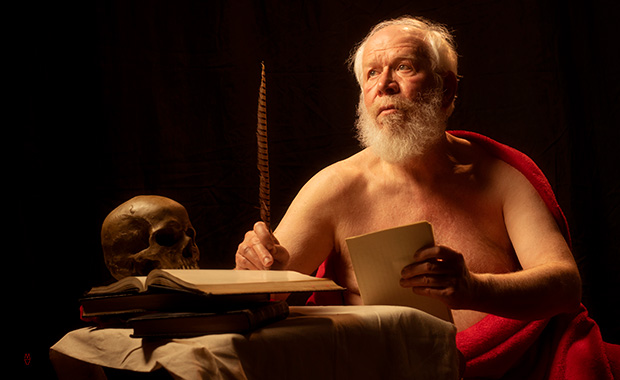I’ve always been fascinated by the work of Caravaggio. It was his technique that first caught my eye. I was amazed at his ability to create such striking human figures with such incredible, near photographic realism, using paint on canvas. His depiction of the human form, of skin, of cloth, engaged me.
When I finally had a chance to view a Caravaggio live I was struck by how much he used texture rather than painted detail to create what I had seen as near pristine reproductions of reality.
His work inspired me and I thought it would be a great challenge to use actual photography to try and capture the kind of theatrical realism he had created.

I choose St. Jerome, as depicted in Caravaggio’s painting (above) as one of the first characters I wanted to re-imagine for modern eyes.
Jerome made the first translation of the Bible into what was then the common language, Latin. Using the best sources available to him at the time, he painstakingly set about translating Hebrew and Aramaic to create what would come to be called the Vulgate, or the Biblia Vulgata, (literally “the Bible in common tongue”). It became the definitive translation of the Bible used by the Catholic Church.
I admired St. Jerome’s dedication to such peaceful, scholarly work.
With that as a starting point, I assembled the appropriate props and engaged a friend who was willing to be my model (Thomas McRoberts of Arlington, VA). I rented a studio in Falls Church Virginia for the shoot.
Thomas actually met me in my hotel room the night before as I was checking out my equipment and, since he was there, we decided to do some testing. We ended up setting up the whole thing in my hotel room as a sort of tech rehearsal. There wasn’t the room to spread out the way I wanted to, but we worked out the details for what we’d do the next day and took some time to experiment with different set ups. We actually got what I felt were some great images, especially for a test.
The next day we met at the studio with just a few hours to load in, set up, shoot, break down and pack out all the gear. I shot both stills and video and with more space was able to do a more accurate recreation of the original Caravaggio image.
But the image we captured that most resembled and matched the original… didn’t speak to me. What did was one of the images we had done in the hotel the night before.
Caravaggio had depicted St. Jerome working methodically, his nose down in his source text, focused on transcribing. But what I wanted to capture was a more human moment. A moment of doubt.
For me the image wasn’t about mechanically translating, but a moment when he had to look to God, searching for guidance to find the right word. This Jerome is gazing toward heaven seeking divine consul.
We all are seeking inspiration in everything we do. Even in everyday speech, we struggle to find the right words. How great the weight Jerome must have known to find the right word when he felt he was literally interpreting sacred and inspired scripture. He must have had doubts. He must have wondered.
It was in that uncertainty I felt his humanity. Questioning yourself, feeling uncertain and looking beyond yourself for guidance as you struggle to do the right thing, is something I can identify with.
For me this depiction of St. Jerome is about a man who, at that moment, isn’t sure of his next choice. He is looking for inspiration beyond himself. He is dedicated to his cause and feels the pressure of what he’s doing. At this moment, he knows his answers must come from above, not from his own pen.
We got shots that were a more exact match to the original Caravaggio, but this is the one that spoke to me.
This is a moment of human doubt, of pausing to consider the right choice. That’s a feeling I relate to.
Thus the title: “St. Jerome: Look to God.”

TRIVIA: Not related to this image, but a fun aside – In the original Ghostbusters, the librarian who saw a ghost at the beginning of the film, is later being questioned by Bill Murray’s character. When he asks her if there is any history of insanity in her family she relies “My uncle thought he was St. Jerome.” The irony, if you realize it, is that St. Jerome is the patron saint of librarians.